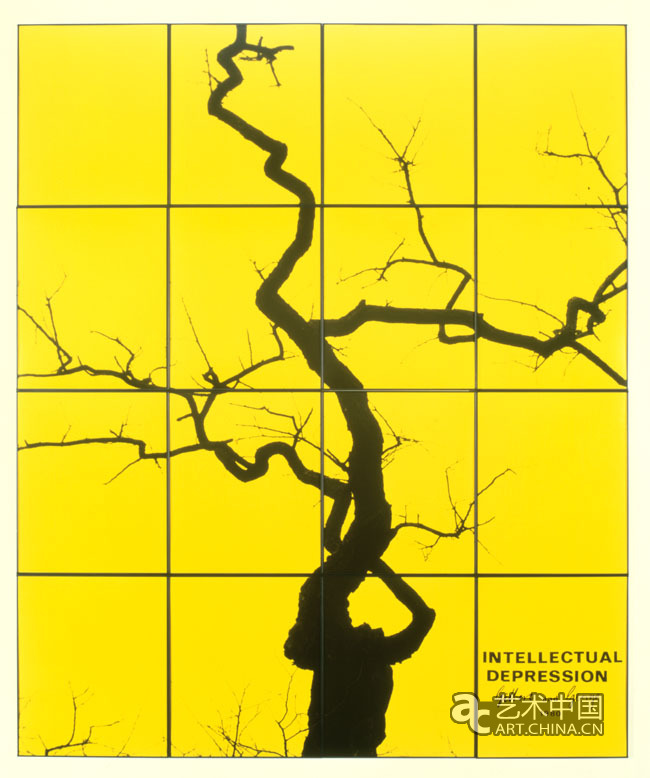吉尔伯特与乔治 -《精神压抑》 |
| 艺术中国 | 时间: 2010-01-29 18:38:21 | 文章来源: 艺术中国 |
|
吉尔伯特与乔治 -《精神压抑》 Gilbert & George Intellectual Depression 1980 Mixed media 242 x 202 cm 吉尔伯特和乔治 精神压抑,1980 混合材料 242 x 202cm
这或许是吉尔伯特与乔治有关黑暗、畸形生长的比喻以及死亡和衰退运行观的最突出画作之一。在浓重的黄色背景上是一棵无叶树的黑色轮廓,似乎向天空伸出扭曲的枝爪。这颗被特写的树长在伦敦的芬斯伯利圆形广场,它是日本政府在第二次世界大战后作为赔偿赠予的礼物。树上粗制的牌子细述了它的历史,不过在吉尔伯特与乔治作画后不久,树和牌子被拆除了。这和同一时期的几个相关研究与一些艺术家表现生命和活力的仓促之作形成了对比。 吉尔伯特与乔治是生活中和艺术上的伙伴,他们创造了一个世界,在这个世界里,他们的所有存在即是一件艺术品。他们最初的作品是“唱歌的雕塑”(1969年),当时他们还是圣马丁艺术学校的学生,他们一起迈开步子并随大萧条时代的歌曲“Underneath the Arches”高唱,从这个作品开始一直到他们永远相互匹配的穿着,他们的整体统一性已经在很大程度上固定下来。他们是英国艺术的知名人物,虽然他们在某种程度上总是以局外人的形式存在——从不轻易远离他们在东伦敦富尔尼耶大街(Fournier Street)的长期居所,每天的同一时间在同一个咖啡馆进餐。吉尔伯特与乔治宣称“全民艺术”,“艺术即生活”。正如他们用独特的修辞风格所诠释的那样,艺术的主题“必须是人类的状况,我们把人类状况看作最高理想。人是万物之中最奇妙的东西,同时艺术的整个形式(颜色和形式)只是用来服务主题,其本身没有什么重要性。我们讨厌为艺术而艺术——我们完全反对这种观点”。[注:与乔治与Irmeline Lebeer的谈话,《艺术杂志》(Art Press)] 吉尔伯特与乔治记录了四十多年来现代生活,生活中的方方面面——包括意外打击、恶俗、神圣以及放浪形骸——都一一收录他们共同的作品之中。不过,1980年,艺术家关注的主题,主要是宗教和绝望——荒芜空虚的生活信仰。20世纪70年代期间,艺术家的作品充满了苦闷并逐渐向压抑、酒精和疯狂等较为阴暗的主题转换,并从早期画作《树枝》(Branch)(1978年)提取主题。在《树枝》中,一个光秃秃的树枝简单轮廓出现在艺术家头上面的红色背景上。 然而,随着这种主题的发展,艺术家的色彩开始丰富起来。最近,吉尔伯特与乔治从黑白单一的图像走出,开始发展一种利用深红色的方法。被称为萧条之年的1980年是他们在相关作品《等待》(Waiting)中使用黄色的第一年。这些颜色(涂在深色的格状结构中)的深度和丰富性制造出彩色玻璃窗户的效果。正如Suzanne Pagé所指出的,“吉尔伯特与乔治同中世纪的艺术家一样,创造了各种形象来使人了解和解释。”我们可以想象,这幅作品所宣扬的讯息是一种警告。1980年的许多画作涉及生活恐惧的美学观,黄色和黑色的使用机会使人生厌,让人想起危险的标志。对于这些有预见性的艺术家而言,他们预见了充满恐惧的时代即将到来,这幅早期画作告诉我们,这种恐惧的环境会对精神对灵魂产生钳制作用。 劳拉•麦克利恩•法里斯 Gilbert & George This is perhaps one of Gilbert & George’s starkest pictures, concerned with imagery of a dark, malformed growth, and orbiting notions of death and decay. A black silhouette of a skeletal leafless tree appears on a rich yellow background, seeming to raise a twisted claw to the sky. The featured tree grew in Finsbury Circus in London, and was a gift from the Japanese government as reparation after World War II. A poorly-made plaque on the tree detailed its history, though both tree and plaque were removed shortly after Gilbert & George’s picture was made. This, along with several related studies from the same period, contrasts with some of the artists’ brasher pictures, which teem with life and activity. Gilbert & George, partners in life and art, have created a universe in which their entire existence is an artwork. From their very first ‘Singing Sculpture’ (1969), made whilst still students at St Martin’s School of Art, and in which they move in synch and sing along with the Depression-era song ‘Underneath the Arches’, through to their unfashionably matching tailoring, their entirety is heavily formalised. They are well-known icons of British art, although they have always, to some extent, existed as outsiders – never venturing very far from their long-term residence in Fournier Street, East London, and eating in the same cafe every day at the same time. ‘Art is for All,’ claim Gilbert & George, and ‘Art is Life.’ As they explain in their inimitable rhetorical style, the subject matter of art ‘must be the human condition: we believe in the human condition as the supreme ideal. Man is the most amazing thing of all and the whole formal side of art – colours and forms – is there only to serve the subject and is of no importance in itself. We hate art for art’s sake – we are totally opposed to it.’ Gilbert & George have been chroniclers of modern life for more than 40 years; and huge swathes of life - shock, shits, crucifixes and hoodies - have met within the confines of their signature grid. The themes that concerned the artists in 1980, however, are governed by the twin poles of religion and despair – a faith in life which is bleak and empty. Intellectual Depression is prefigured by a gradual move during the 1970s towards darker themes such as depression, alcohol and madness, and draws on a motif of an earlier picture, Branch (1978) , in which the austere silhouette of a naked branch appears against a red background above the heads of the artists. Alongside these thematic developments, however, was the start of a new kind of richness in the artists’ palette. Gilbert & George had recently moved away from black and white monochrome images, and had begun to develop a process employing a deep red. The year of Intellectual Depression, 1980, was the first that they used the colour yellow, in a related picture, Waiting. The depth and richness of these hues, fixed within a dark grid-like structure, creates the impression of stained-glass windows. As Suzanne Pagé has noted, ‘Like the artists of the Middle Ages, Gilbert & George create images to initiate and explain.’ We might imagine that the message preached in this work is a type of warning. Many pictures from 1980 concern the aesthetics of living with fear, and the use of yellow and black is almost sickly, recalling a hazard sign or a wasp. For such prescient artists, who prefigured an age in which terror would have such an inflated currency, this early picture barks a lesson at us about the effect of strangulation that any such climate of fear has on the intellect, and on the soul. Laura McLean-Ferris
|
| 注:凡注明 “艺术中国” 字样的视频、图片或文字内容均属于本网站专稿,如需转载图片请保留 “艺术中国” 水印,转载文字内容请注明来源艺术中国,否则本网站将依据《信息网络传播权保护条例》维护网络知识产权。 |
